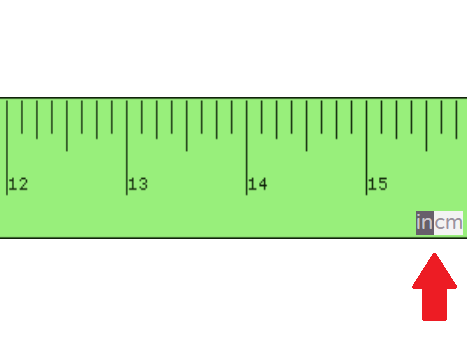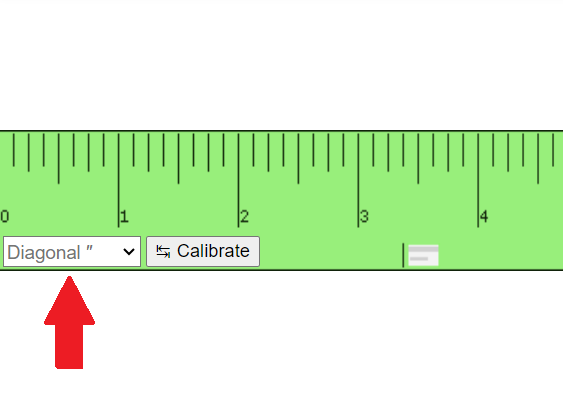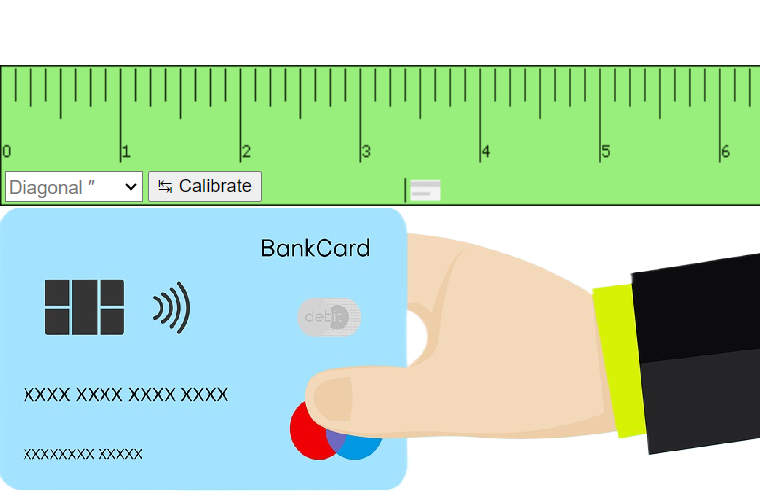Sometimes we need to measure the length of different objects and don’t have a ruler nearby, the online ruler can be the perfect solution as it is a 100% effective utility. This virtual ruler allows you to have a life-sized ruler to measure the length of small objects in inches centimeters or millimeters.
To use the digital ruler, you just have to select the desired unit of measurement: inches (green color) = IN and centimeters (gray color) = CM. It is available at the bottom right corner of the ruler, as shown in this image.

Only calibration of the ruler is missing, by entering the diagonal or size of your screen. There are two options to do this:
- You can enter the number directly and then click on “Calibrate,” as shown in this image.

- Use a credit card, debit card, or similar as a reference. The longest side measures 3.37 inches (3 3⁄8 inches) or 85.6 mm (8 centimeters, 56 millimeters). Place the card directly under the ruler at the left end and adjust the diagonal measurements until the painted mark on the ruler aligns with the right edge of the card, following the visual reference provided in the following image.

If you don’t know the exact value of your screen’s diagonal, you can find this information in the technical documentation of your device or directly search the internet for the diagonal of your device’s screen.
Once the online calibration of the ruler is completed, you can start using it to measure the length of objects to your liking. This virtual ruler is especially useful for measuring small or medium-sized objects, as it allows for high precision in measurements.
What is an Online Ruler?
In the digital era, the online ruler has become essential for conducting measurements efficiently and precisely. This virtual variant of the traditional physical ruler allows for the measurement of distances and dimensions directly from electronic devices such as computers, tablets, or mobile phones.
The online ruler operates through a calibration process that adjusts its virtual scale to the real dimensions of the object being measured. This adjustment ensures accurate and reliable measurements. Versatility is one of the distinctive features of the online ruler, as it allows users to switch between different units of measurement according to their needs, offering flexibility for various contexts.
Accessibility is another prominent advantage of the online ruler. By being able to access this tool through the internet, the need to rely on a physical ruler is eliminated, allowing measurements to be taken at any time and place. This makes it a valuable tool for both students working on academic tasks and professionals requiring precise measurements in their projects.
The online ruler has modernized the way we conduct measurements, providing a precise and user-friendly digital alternative. Its ability to adapt to different devices, offer various units of measurement, and provide accessibility through online connectivity makes it an indispensable tool in the digital era.
Features and Advantages of an Online Ruler
In the digital era, the online ruler has emerged as an essential tool, revolutionizing the way we conduct measurements. Its features and advantages make it a practical and efficient option for a variety of applications.
Features
- Precise Calibration: The online ruler allows for precise calibration, adapting to the real dimensions of the object being measured. This ensures accurate and reliable measurements.
- Versatility of Units: One standout feature is its ability to switch between different units of measurement, such as centimeters, inches, or millimeters, catering to user preferences or project requirements.
- Accessibility: Being available online, the online ruler offers accessibility from any device with an internet connection, eliminating the dependence on physical tools.
- Device Adaptability: It can be used on a variety of electronic devices, from desktop computers to tablets and mobile phones, making it versatile and convenient.
Advantages
- Precision: The precise calibration and adaptability to different units ensure accurate measurements, crucial in fields like engineering, architecture, or manufacturing.
- Elimination of Physical Limitations: By foregoing a physical ruler, size and space restrictions are lifted, allowing measurements of objects of any length.
- Time Savings: Accessibility and user-friendly features contribute to significant time savings compared to traditional methods, especially in professional environments where efficiency is crucial.
- Remote Collaboration: Facilitates remote collaboration by allowing users to share measurements instantly, valuable in teams with geographical dispersion.
- Continuous Updates: As a digital tool, the online ruler can receive continuous software updates and improvements, ensuring users always have access to the latest features.
Who Invented the Ruler?
The history of the ruler has its roots in ancient civilizations seeking precise methods of measurement. While it cannot be attributed to a single person, various cultures contributed to the development of this instrument over time.
In ancient Greece, for example, rudimentary rulers were used for geometric measurements. Greek philosophers and mathematicians like Euclid contributed to the mathematical theory behind linear measurements.
In the medieval Islamic world, significant advancements were made in geometry and trigonometry, influencing the development of more accurate measuring instruments. The ruler and compass, fundamental tools in geometric construction, played a crucial role.
During the Renaissance in Europe, there was an explosion of knowledge and creativity, and measuring instruments experienced improvements. Artists and scientists like Leonardo da Vinci used rulers for their studies and works.
In the modern era, with the onset of the industrial revolution, rulers were mass-produced and standardized for use in various fields from architecture to engineering.
Uses of an Online Ruler
The online ruler has proven to be a versatile and valuable tool in various applications. Its utility extends across different fields, from education to engineering and design. Among the numerous uses of an online ruler are:
- Precise Measurements: The online ruler allows for accurate measurements of lengths, widths, and various dimensions. Its ability to adapt to different units facilitates the precise capture of results.
- Graphic Design: In the field of graphic design, the online ruler becomes an essential tool for aligning elements, measuring distances, and ensuring symmetry in visual projects.
- Distance Education: In remote learning environments, the online ruler facilitates virtual measurements for students and teachers, contributing to the interactive teaching of geometric concepts.
- Architecture and Construction: Professionals in architecture and construction use the online ruler for quick and accurate measurements in digital plans, streamlining the design and planning process.
- Scientific Work: In scientific research, the online ruler is used to measure data in charts and studies, adding precision to data collection.
- Office Tool: In office environments, the online ruler becomes a practical tool for measurements in digital documents, streamlining tasks such as designing presentations and documents.
- Sewing and Fashion: In the world of fashion and sewing, the online ruler is useful for measuring patterns and garment dimensions, facilitating the work of designers and tailors.
- Jewelry and Product Design: Professionals in jewelry and product design use the online ruler to specify the dimensions of their creations, ensuring coherence in the manufacturing process.
Sizes of Rulers
| Ruler 1 in | Ruler 51 in |
| Ruler 2 in | Ruler 52 in |
| Ruler 3 in | Ruler 53 in |
| Ruler 4 in | Ruler 54 in |
| Ruler 5 in | Ruler 55 in |
| Ruler 6 in | Ruler 56 in |
| Ruler 7 in | Ruler 57 in |
| Ruler 8 in | Ruler 58 in |
| Ruler 9 in | Ruler 59 in |
| Ruler 10 in | Ruler 60 in |
| Ruler 11 in | Ruler 61 in |
| Ruler 12 in | Ruler 62 in |
| Ruler 13 in | Ruler 63 in |
| Ruler 14 in | Ruler 64 in |
| Ruler 15 in | Ruler 65 in |
| Ruler 16 in | Ruler 66 in |
| Ruler 17 in | Ruler 67 in |
| Ruler 18 in | Ruler 68 in |
| Ruler 19 in | Ruler 69 in |
| Ruler 20 in | Ruler 70 in |
| Ruler 21 in | Ruler 71 in |
| Ruler 22 in | Ruler 72 in |
| Ruler 23 in | Ruler 73 in |
| Ruler 24 in | Ruler 74 in |
| Ruler 25 in | Ruler 75 in |
| Ruler 26 in | Ruler 76 in |
| Ruler 27 in | Ruler 77 in |
| Ruler 28 in | Ruler 78 in |
| Ruler 29 in | Ruler 79 in |
| Ruler 30 in | Ruler 80 in |
| Ruler 31 in | Ruler 81 in |
| Ruler 32 in | Ruler 82 in |
| Ruler 33 in | Ruler 83 in |
| Ruler 34 in | Ruler 84 in |
| Ruler 35 in | Ruler 85 in |
| Ruler 36 in | Ruler 86 in |
| Ruler 37 in | Ruler 87 in |
| Ruler 38 in | Ruler 88 in |
| Ruler 39 in | Ruler 89 in |
| Ruler 40 in | Ruler 90 in |
| Ruler 41 in | Ruler 91 in |
| Ruler 42 in | Ruler 92 in |
| Ruler 43 in | Ruler 93 in |
| Ruler 44 in | Ruler 94 in |
| Ruler 45 in | Ruler 95 in |
| Ruler 46 in | Ruler 96 in |
| Ruler 47 in | Ruler 97 in |
| Ruler 48 in | Ruler 98 in |
| Ruler 49 in | Ruler 99 in |
| Ruler 50 in | Ruler 100 in |